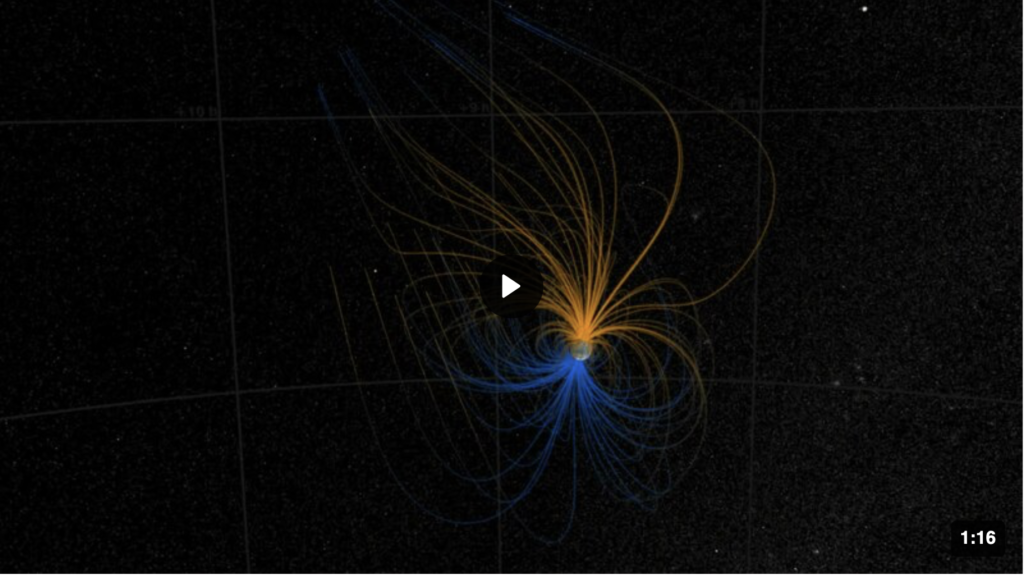
Size comparison of Venus and Earth. Approximate scale is 29 km/px. Credit: NASA
By Mariana Meneses
Venus and Earth both formed around the same time, 4.6 million years ago, from a common disc of gas and dust spinning around the Sun.
Although they share features like a rocky core, silicate rock/metallic composition, comparable sizes (Venus is only about 5% smaller than Earth), similar densities, and atmospheres, the two planets exhibit significant differences.
Time is among the major differences. Venus, with a yellow/white hue from its cloudy atmosphere, rotates in the direction opposite to Earth, with one day on Venus lasting about 243 Earth days.
Despite their similarities, Venus stands out with its scorching average surface temperature of 464 °C, in stark contrast to Earth’s milder 15°C. Additionally, Venus’ atmosphere consists of approximately 96.5% CO2 and 3.5% Nitrogen, while Earth’s atmosphere is predominantly composed of 78% Nitrogen and 21% Oxygen.
One important distinction between the two is the presence of a magnetic field.
Earth has a robust intrinsic magnetic field generated by the molten iron and nickel within its core, serving a vital role in shielding the planet from solar radiation. In contrast, Venus lacks an intrinsic magnetic field and relies on the interaction between the solar wind and the planet’s ionosphere to generate a feeble magnetic field.

Schematic representation of Earth’s magnetic field lines. Image: Zureks
The absence of an intrinsic magnetic field on Venus is thought to be due to the lack of internal churning in its liquid core.
However, as recently pointed out by Jonathan O’Callaghan for Quanta Magazine, astronomers have long been puzzled by planetary magnetic fields, as there seems to be no consistent rule governing their presence in our solar system.
A study by Seth A. Jacobson and co-authors, published in 2017 in the journal Earth and Planetary Astrophysics, suggested that the absence of a global magnetic field on Venus compared to Earth might be attributed to a critical difference in their evolutionary histories. While both planets have cores that make up about half of their radius and roughly 15% of their volumes, Earth experienced a catastrophic collision with a Mars-size impactor during its formation, which is widely theorized to have led to the Moon’s creation.
The impact caused significant disruption in the layers of different materials within Earth’s core.
As a result of this disruption, the materials in the core became more mixed, losing their distinct layers. This blending of materials promoted the movement of heat through the core in a process known as convection. In simpler terms, it’s like stirring a pot of soup where the heat from the bottom moves upward, creating circulating currents.
This convection process not only distributed heat but also played a crucial role in the development of a powerful, global magnetic field around Earth.
In contrast, Venus did not undergo a similarly late and strong collision, allowing compositional layering to persist in its core and hindering the formation of a global magnetic field. The study proposes that this difference in their evolutionary paths explains the magnetic field disparity between Earth and Venus.
Model of the Earth’s magnetic field
Astronomers believe that studying exoplanets, which are planets orbiting stars beyond our solar system, is a key to unraveling the mysteries of planetary magnetism.
Detecting and analyzing magnetic fields on exoplanets can provide insights into their formation, evolution, and potential for habitability.
Despite the challenges in detecting faint exoplanetary magnetic fields, observations of YZ Ceti b, a rocky exoplanet orbiting a red dwarf star, have shown promising signs. Two independent teams observed periodic bursts of radio waves, which are indicative of a magnetic field on the planet. These results may suggest potential habitability, providing a promising method for evaluating magnetic fields on rocky, Earth-like exoplanets.

The sun’s magnetic field. Credit: NASA
The Sun’s magnetic field results from the intricate interplay of conductive plasma motion within the solar interior, a process known as the solar dynamo. This dynamic system, fueled by nuclear fusion heat at the Sun’s core, generates various effects, including solar explosions impacting space weather on Earth and the interplanetary magnetic field crucial for spacecraft traversing the solar system. Although both the Sun and Earth possess magnetic fields, their origins, characteristics, and effects differ significantly.
Magnetic fields serve crucial roles, acting as protective shields against cosmic radiation and solar particles which is essential for sustaining life on Earth. Additionally, Earth’s magnetic field aids navigation through its poles, and leaves a distinct imprint on the landscape for resource exploration, in terms of magnetic properties of different geological formations.
Different geological formations have different magnetic properties, and these can be detected and analyzed to aid in the search for natural resources.
Certain minerals, such as iron, are magnetic, and their presence can affect the local magnetic field. Geologists and resource exploration companies use instruments to measure these variations in the Earth’s magnetic field to help locate deposits of these minerals. This technique is known as magnetic surveying or magnetometry.
As astronomers explore exoplanets and stars outside our solar system, detecting and understanding magnetic fields becomes crucial. Discoveries from these investigations can unravel mysteries in planetary science, enhancing our comprehension of planetary formation, evolution, and potential for habitability.
Interested in exploring related topics? Discover these recommended TQR articles:
Searching For Martian Life with X-Ray Crystallography
Technology Fuels Advances in Citizen Science
Beyond the Binary: Can Machines Achieve Conscious Understanding?




